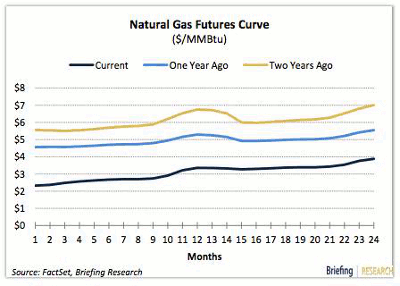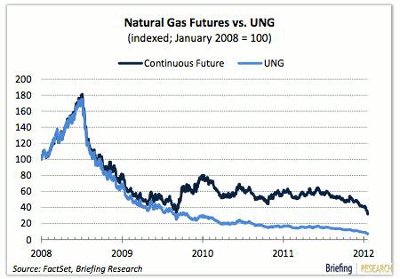Briefing.com profiles recent price behavior in the United States Natural Gas Fund (UNG), showing the costly tracking errors that serve as one of the primary risk factors for new positions in this fund.
We thought it was important to point out the consequences of falling prices on the primary ETF used by investors for exposure to natural gas: the United States Natural Gas Fund (UNG). This vehicle has been a devastating choice for those playing from the long side in search of an important investable bottom, albeit devastating for interesting reasons.
If it seems as though UNG lags natural gas prices on advances, and falls apart even more on declines, that is because that is exactly what is happening. The problem for UNG is contango (future contracts pricing at successively higher prices than front-month contracts) in the futures curve as a chronic condition over recent years in natural gas. This state results essentially in a cost taken by the ETF when rolling exposure from one contract to another.
In effect, one can think of the long-term UNG chart as a chart of investment returns in natural gas that includes the cost of contango, while the continuous contract futures chart shows a better representation of the actual price movement for natural gas over time.
Most retail participants are likely not aware of this distinction, and just end up determining that reversion to the mean is a good enough reason to bottom pick in UNG. Such positions from the $8-$10 area are likely in some form of liquidation here due to the pain of this unflagging downtrend. That process is probably responsible for much of the acceleration in pressure in recent days.
That is hardly fodder for a technical low, but capitulation is an important part of the process (shifting a market into new strong hands once older strong hands have been turned “weak” due to taking too much paper pain).
If you are just now considering a short at these levels, do so carefully. Capitulation downtrends can often be followed by reversal bounces.
See also: The Hidden Danger in Energy ETFs
By the Staff at Briefing.com




















